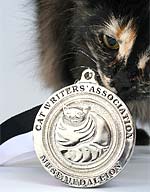 |
|||||||||||||||||||
|
|

We are the proud winners of the 2006 - 2009 winner of the Muse Medallion for Online Magazine by The Cat Writers? Association in their annual Communications Contest! (Photo courtesy of Weems Hutto).
On November 17, 2007 Felinexpress.com was honored to receive The President's Award by the Cat Writers' Association. We are very proud to have earned this distinction and will continue to provide quality information for all cat lovers.
Felinexpress.com Home > Cat Health > Feline Calicivirus |
Feline Calicivirus
The principal components of the feline respiratory disease (also known as the kitty cold) are feline viral rhinotracheitis and feline calicivirus. Most cats come into contact with these two viruses in their lifetime, but those cats who have been vaccinated or are equipped with a strong immune system can quickly shake off the disease. Vulnerable to the calicivirus are young kittens and unvaccinated cats. Cats or kittens who contract the calicivirus can then become lifetime carriers of this disease.
Early symptoms of the calicivirus include fever, cough, and excessive drooling. As the disease steadily takes hold in the kitten’s system, you will see mouth ulcers popping up (small red bumps on the tongue and roof of the mouth). These mouth ulcers can lead to chronic gingivitis later in life. Ulcers can also form between the toes or on the pads of the kitten’s feet. Nasal ulcers are also common.
In order to breathe, the kitten will begin to open mouth breathe, introducing airborne bacteria into the mouth thus exacerbating the condition. Loss of appetite will soon follow especially if the nose isn’t kept clear of discharge. If the kitten can’t smell, he won’t eat. The kitten becomes lethargic, dehydrated and anorexic. He will also display joint weakness showing a distinctive limp when moving about. Calicivirus is prevalent in cats and kittens kept in overcrowded conditions such as rescue shelters, multi-cat homes and pet shops. Stress is a common factor in triggering the calicivirus.
The virus seems to be mutating in an unhealthy direction. In her upcoming book Cat Wrangling (due out November 2007) author, Dusty Rainbolt explores the newest form of the calicivirus that is “claiming over 50% of its victims.” The vets are puzzled by this newest deadly strain that appears to be resistant to all wide spectrum antibiotics.
The calicivirus can spread through direct contact with infected saliva, feces, and nasal discharge. Owners are advised to keep infected kittens and cats away from the resident cats and to follow strict hygiene when handling an ill kitty. Dishes should be washed in a bleach and hot water mixture after every meal.
The virus sits in the system incubating for fourteen days after exposure before it strikes. It can live outside the kitten’s body for eight to ten days. Treated, it can last up to two weeks, untreated; it can quickly take a kitten’s life.
Generally the calicivirus is diagnosed by evaluating the kitten’s history, and looking at the clinical signs. The most obvious signs are the ulcers and the lack of sneezing.
Treatment
The calicivirus is warded off by the vaccination FVRCP or the three in one shot. This vaccine is known as a core vaccine and offers some protection against panleukopenea, herpesvirus and calicivirus. This vaccine should be given to a kitten that is 6-8 weeks old with boosters every 3-4 weeks until the kitten reaches 12 weeks old. The vaccine has been successful in providing immunity for three years according to Dr. Arnold Plotnick MS, DVM, ACVIM, ABVP in his article Vaccination Protocol located at http://www.manhattancats.com/
Once infected, the kitten is best tended at home with supportive care. Fluids need to be pushed and the kitten should be tempted by tasty morsels of food so that he doesn’t become anorexic. Smelly mackerel in water, sardines in oil, canned tuna cat food, and pieces of raw fish are good taste tempters for a reluctant eater.
Using saline nasal spray to keep the sinuses open will also help the kitten breathe easier. Vaporizers will aid in the breathing process. The kitten should be in a warm but ventilated room and out of drafts. Talk to your vet about what antibiotics best treat the calicivirus and explore pain medications if the kitten seems uncomfortable.
If you have an infected kitten, don’t despair. With a little TLC and a bit of time you can successfully combat this disease. Be sure, if you live in a multi-cat home and your latest arrival is infected, that your other cats have been vaccinated against this disease before allowing the kitten into general population.
More cat breeds |
|
? Copyright 2006-2010 Felinexpress.com, All Rights Reserved
Privacy Statement - Disclaimer - About Me


